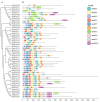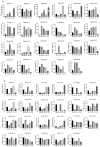Identification and Characterization of NAC Transcription Factors Involved in Pine Wilt Nematode Resistance in Pinus massoniana
- PMID: 40805748
- PMCID: PMC12349346
- DOI: 10.3390/plants14152399
Identification and Characterization of NAC Transcription Factors Involved in Pine Wilt Nematode Resistance in Pinus massoniana
Abstract
Pinus massoniana Lamb. is an economically important conifer native to China. However, it is highly susceptible to the pine wood nematode (Bursaphelenchus xylophilus, PWN), the causal agent of pine wilt disease (PWD), resulting in substantial ecological and economic losses. To elucidate potential molecular defense mechanisms, 50 NAC (NAM, ATAF1/2, and CUC2) transcription factors (PmNACs) were identified in the P. massoniana genome. Phylogenetic analysis divided these PmNACs into seven subfamilies, and motif analysis identified ten conserved motifs associated with stress responses. Twenty-three genes were selected for expression analysis in various tissues and under exogenous salicylic acid (SA), methyl jasmonate (MeJA), and PWN infection. Six genes (PmNAC1, PmNAC8, PmNAC9, PmNAC17, PmNAC18, and PmNAC20) were significantly up-regulated by both hormonal treatment and PWN infection, implying their involvement in JA/SA-mediated immune pathways. Functional characterization showed PmNAC8 is a nuclear-localized transcription factor with autoactivation activity. Furthermore, transient overexpression of PmNAC8 in Nicotiana benthamiana induced reactive oxygen species (ROS) accumulation and necrotic lesions. Collectively, these results elucidate NAC-mediated defense responses to PWN infection in P. massoniana and identify candidate genes for developing PWD-resistant pine varieties.
Keywords: Bursaphelenchus xylophilus; NAC family; hormones; pine wilt disease; subcellular localization; transcription factor.
Conflict of interest statement
The authors declare no conflicts of interest.
Figures









Similar articles
-
Metabolome analysis and functional characterization reveals that d-gluconic acid contributes to pine defence against Bursaphelenchus xylophilus infection.Pest Manag Sci. 2025 Aug 14. doi: 10.1002/ps.70146. Online ahead of print. Pest Manag Sci. 2025. PMID: 40814169
-
Functional chitinases enhancing Pinus massoniana resistance to Bursaphelenchus xylophilus.Pest Manag Sci. 2025 Aug 2. doi: 10.1002/ps.70105. Online ahead of print. Pest Manag Sci. 2025. PMID: 40751413
-
Resistant and Susceptible Pinus thunbergii ParL. Show Highly Divergent Patterns of Differentially Expressed Genes during the Process of Infection by Bursaphelenchus xylophilus.Int J Mol Sci. 2023 Sep 21;24(18):14376. doi: 10.3390/ijms241814376. Int J Mol Sci. 2023. PMID: 37762682 Free PMC article.
-
Comprehensive Insights Into Pinewood Nematode Effectors: Evolutionary Diversity, Functional Roles, and Implications for Pine Wilt Disease Management.Plant Cell Environ. 2025 Sep;48(9):6748-6764. doi: 10.1111/pce.15655. Epub 2025 Jun 2. Plant Cell Environ. 2025. PMID: 40452563 Review.
-
Molecular Mechanisms of the Biological Control of Pine Wilt Disease Using Microorganisms.Microorganisms. 2025 May 26;13(6):1215. doi: 10.3390/microorganisms13061215. Microorganisms. 2025. PMID: 40572104 Free PMC article. Review.
References
-
- Tang F., Zhou Y., Feng J., Li J., Feng J., Lv Y., Mao Y., Wang Y., Deng P., Bai Y. Important Role of Pinus Massoniana Mixed Forests in Enhancing Soil Carbon Stocks in Degraded Forests in Southern China. CATENA. 2025;250:108792. doi: 10.1016/j.catena.2025.108792. - DOI
-
- Xu S., Huang W., Wang D., Zhang B., Sun H., Yan J., Ding J., Ma X. Risk Assessment of Carbon Stock Loss in Chinese Forests Due to Pine Wood Nematode Invasion. Forests. 2025;16:315. doi: 10.3390/f16020315. - DOI
Grants and funding
LinkOut - more resources
Full Text Sources

